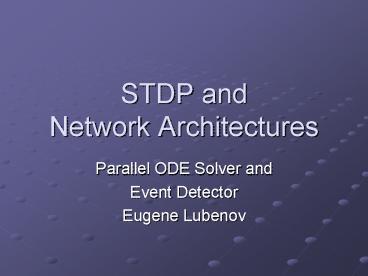STDP and Network Architectures - PowerPoint PPT Presentation
1 / 22
Title:
STDP and Network Architectures
Description:
Spike-Timing Dependent Plasticity. Bi & Poo, J. Neurosci. ( 1998) ... http://www.mathworks.com/ SUNDIALS (LLNL) http://www.llnl.gov/CASC/sundials/ LAM MPI ... – PowerPoint PPT presentation
Number of Views:235
Avg rating:3.0/5.0
Title: STDP and Network Architectures
1
STDP and Network Architectures
- Parallel ODE Solver and
- Event Detector
- Eugene Lubenov
2
Networks of Neurons
GE
GI
GR
3
Spike-Timing Dependent Plasticity
Bi Poo, J. Neurosci. (1998).
4
Integrate-and-Fire Neuron Model
ODE System for the Membrane Potential
V ge gi
y f (y, t)
y
Special Events
e (y, t) V V_th
5
STDP Model
ODE System for the STDP Variables
Special Events
Weight Matrix Update Rules
NE
NN
output (Pe)
output (Pr)
NN
NN
GE
GR
input (M)
input (M)
6
Project Ingredients
- Matlab (Mathworks)
- http//www.mathworks.com/
- SUNDIALS (LLNL)
- http//www.llnl.gov/CASC/sundials/
- LAM MPI
- http//www.lam-mpi.org/
- Custom C Code
7
Why Matlab?
- ode suite
- event functions
- knowing what to expect
- MAT library
- loading parameters and input
- saving output
- BUT SERIAL ONLY and SLOW
8
Why SUNDIALS
- SUite of Nonlinear and DIfferential/ALgebraic
equation Solvers - Adams-Moulton (non-stiff), BDF (stiff)
- Variable Step, Variable Order (12, 5)
- Functional Iteration, Linear System
- Direct (full, banded, diag approx J)
- Iterative (GMRES)
- Sclaled Preconditioned (SPGMR)
- BUT NO EVENT FUNCTIONS
9
Why LAM MPI?
- Multiple Processors
- Solve larger problems
- Solve problems faster
- Portable Code
- BUTProblem granularity must be suited to
- underlying architecture
- Beowulf cluster coarse granularity
10
Why Custom C Code?
- Extend CVode with Event Capabilities
- Problem specific routines f(.), e(.)
- Handle I/O and Message Passing
- Inline Exponential Variables
- BUT
- compatibility mpicc, mex, gcc
- memory Calloc, mxCalloc, CVodeMalloc
- debugging parallel code
11
Performance Serial vs Parallel
12
Performance Parallel Scalability
13
Problem Stiffness
Moderately Stiff?
WRONG!
Non-Stiff!
14
Correctness V
15
Correctness M, Pe, Pr
16
Correctness GE, GR
17
Network Activity
Poisson Inhibition
Rhythmic Inhibition (10 Hz)
18
Network Activity
GE plasticity only
GR plasticity only
19
Network Weights
GE Weight Matrix
GE Weight Distribution
20
Network Weights
GR
tr(GR) 0 and GRGR 0
21
Conclusion
- Serial Code (v 2.3.4) good for real problems.
- Parallel Code (v 1.1.0) needs work, but speedup
might be hard to get. - Parallel Code (v 1.2.0) implements asynchronous
message passing, but still in alpha. - Structure emerges from simulations.
22
Future Directions































